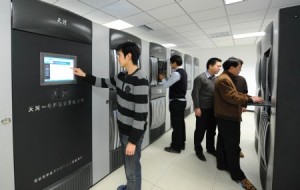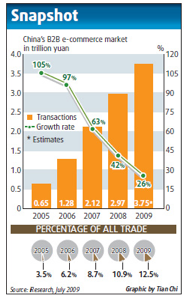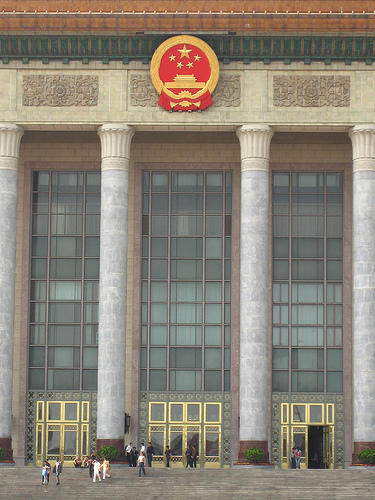ICT Employment Opportunities: Stage 4

Many jobs in China still require little to no skill, such as those in manufacturing of simple items like textiles. Many job seekers coming from the countryside often can only perform these tasks.
While the state of the global economy has continued to struggle, China is one of the few countries where the ICT services employment has be consistently positive. In fact as of the 4th quarter in 2009, China has seen a stronger employment growth than most countries. In 2002, ICT services wages were very high, as much as 3x that of the national average. Despite the low education level of migrant workers, those that are skilled can see definite advantages, meaning China is in Stage 4.
B2C Electronic Commerce: Stage 3
Thanks to the growing change in e-commerce business models, retail stores are seeing an increase in sales several of these changes include, bulk purchase trends, a shift toward mobile platform development. Businesses are paying attention to the customer experience and offering transaction safety guarantees.
IResearch has estimated by the end of 2010 these will have been 145 million online shoppers in China. Described as being relatively young, between ages 18-35, with women slightly edging out men in number of shoppers, the number of online shoppers will only grow in China.
Lastly, improving business logistics is creating a higher quality services for customers. Beginning in 2000, one-third of surveyed Internet users had carried out some B2C electronic commerce with that number jumping to 40% by 2004. Significant increases continue with the advent of mobile platform entering e-commerce.
B2B Electronic Commerce: Stage 3-4
China's Business-to-Business E-Commerce sales continue to grow. The China News Daily reports a 26% increase in transactions in the year 2009. Now comprising 12.5% of all trade in China in 2009, from 10.9 in 2008

In 2003, Alibaba.com released Alipay, a B2B online platform service similar to PayPal. Alipay allows secure transactions to take place online. Online payment has become the web application with the fastest growth of users. In 2010, China utilization of online payment is 30.5% and increase of 36.2% since mid 2009. During this same period of time, foreign investors began partnering with Chinese firms opening more of the world to consumers.
Currently, consumer-to-consumer (C2C) sellers represent the largest market segment of electronic commerce. However, as these individual retailers continue to succeed, they are beginning to grow and can no longer manage themselves as single person operations. Instead, the businesses must transform into larger enterprises, thereby transforming into B2C retailers.
The Chinese government is supportive of these entrepreneurs, even though they are not fully developed. For that reason, China is between Stage 3 and 4 for B2B commerce.
E-Government: Stage 2-3

The Chinese government recognizes the advantages technology like the Internet can provide for them. The benefits are numerous, from taking advantage of a new commercial portal to the further distribution of Party themes. According to CCNIC, 45,000 websites are registered to the Chinese government, including a Chinese language portal at gov.cn and an English version at english.gov.cn.
However, the government is trying to balance the amount of liberty citizens have with the Internet while controlling and not allowing for it to become a tool used against the government. As a result, websites are not as useful as it should be, meaning China is somewhere between Stage 2 and 3.